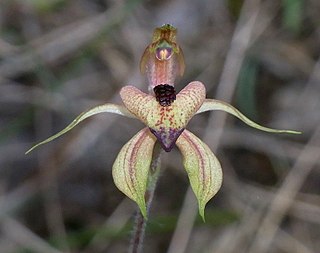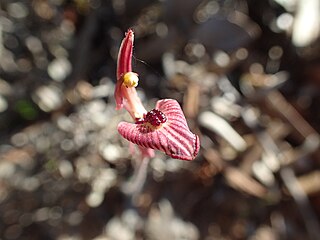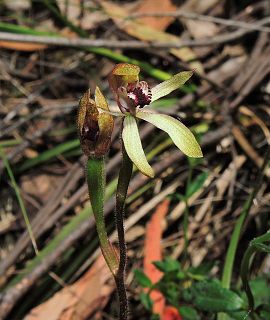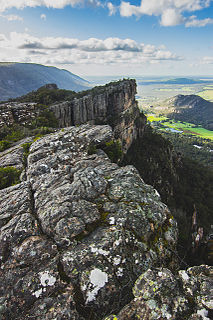
Caladenia angustata, commonly known as white caps is a species of orchid endemic to Tasmania. It has a single, hairy leaf and one or two white to pinkish flowers which are reddish or greenish on their backs. It has not been accepted as a separate species by some authorities who regard it as a synonym of Caladenia gracilis.

Caladenia gracilis, commonly known as musky caps or musky caladenia, is a plant in the orchid family Orchidaceae and is endemic to eastern and south-eastern Australia, including Tasmania. It is a ground orchid with a single leaf and up to six flowers which are dark-coloured on the back and white on the front, sometimes tinged with pink and with a strong musky or soapy odour. The species is also known as Caladenia moschata in Victoria.
Caladenia argocalla, commonly known as white beauty spider orchid, is a plant in the orchid family Orchidaceae and is endemic to South Australia. It is a ground orchid which grows singly or in loose groups and has a single, hairy leaf and one or two white to greenish-white flowers on a wiry, hairy stalk. The total population is thought to be between 2,000 and 4,500 and it is classed as an "Endangered" species.

Caladenia cardiochila, commonly known as thick-lipped spider-orchid, fleshy-lipped caladenia and heartlip spider-orchid, is a plant in the orchid family Orchidaceae and is endemic to Victoria and South Australia. It is a ground orchid with a single hairy leaf and one or two yellowish-green, red-striped flowers on a thin, wiry stem.

Caladenia clarkiae, commonly known as pink caps, is a plant in the orchid family Orchidaceae and is endemic to south-eastern Australia. It is a ground orchid which grows singly or in small groups in Victoria and New South Wales. It has a single leaf and usually one or two white to pale pink flowers with darker pink tips.

Caladenia clavescens is a plant in the orchid family Orchidaceae and is endemic to central Victoria in Australia. It is a ground orchid with a single hairy leaf and usually a single dark red to maroon flower.

Caladenia cucullata, commonly known as the hooded caladenia, is a plant in the orchid family Orchidaceae and is endemic to south-eastern Australia. It is a ground orchid with a single, sparsely hairy leaf, and up to seven white flowers with a purplish labellum.

Caladenia dimorpha, commonly known as spicy caps, is a plant in the orchid family Orchidaceae and is endemic to New South Wales. It is an uncommon ground orchid with a single sparsely hairy leaf, and up to three white flowers which often have pinkish markings.
Caladenia fuscolutescens, commonly known as the ochre spider orchid, is a species of orchid endemic to the south-west of Western Australia. It has a single, hairy leaf and one or two brownish-yellow flowers with a pale yellow, red-striped labellum. It is most common in spring after bushfires in the previous summer.
Caladenia helvina, commonly known as the summer spider orchid, is a plant in the orchid family Orchidaceae and is endemic to Tasmania. It is a ground orchid with a single hairy leaf and usually a single greenish-yellow to pale yellow flower with reddish teeth on the sides of the labellum and reddish calli along its mid-line.

Caladenia macrostylis, commonly known as the leaping spider orchid, is a species of orchid endemic to the south-west of Western Australia. It has a single, hairy leaf and up to three distinctive pale greenish-yellow and red flowers with a cluster of deep purplish calli in the centre of its labellum.

Caladenia montana, commonly known as the mountain spider orchid is a plant in the orchid family Orchidaceae and is endemic to New South Wales, Victoria and the Australian Capital Territory. It is a ground orchid with a single leaf and a single greenish-cream to cream flower, sometimes with reddish markings. It only grows in high montane forests.

Caladenia moschata, commonly known as musky caps or musky caladenia, is a plant in the orchid family Orchidaceae and is endemic to eastern and south-eastern Australia, including Tasmania. It is a ground orchid with a single leaf and up to five flowers which are dark-coloured on the back and white on the front, sometimes tinged with pink and with a strong musky or soapy odour. The species was previously known as Caladenia gracilis.
Caladenia oreophila is a plant in the orchid family Orchidaceae and is endemic to south-eastern Australia. It is a ground orchid with a single leaf and a single greenish-cream flower with pale red stripes a red labellum with a greenish-cream base.
Caladenia osmera is a plant in the orchid family Orchidaceae and is endemic to south-eastern Australia. It is a ground orchid with a single leaf and one or two greenish-cream flowers with pink stripes and which has a sharp odour resembling burnt plastic.

Caladenia pachychila, commonly known as the dwarf zebra orchid, is a species of orchid endemic to the south-west of Western Australia. It has a single erect, hairy leaf and one or two greenish-yellow and red flowers with a red-striped labellum which has a dense cluster of deep purple calli in its centre. It is similar to the zabra orchid but has smaller flowers and the lateral sepals do not clasp the ovary.

Caladenia parva is a plant in the orchid family Orchidaceae and is endemic to south-eastern Australia. It is a ground orchid with a single leaf and one or two green flowers with red stripes along the sepals and petals.

Caladenia phaeoclavia, commonly known as the brown-clubbed spider orchid is a species of orchid endemic to New South Wales. It has a single, hairy leaf and a single light to dark green flower with red stripes and thick, brownish club-like tips on the sepals.

Caladenia prolata, commonly known as long-leaf fingers or white fingers is a plant in the orchid family Orchidaceae and is endemic to southern Australia. It is a ground orchid with a single leaf and one or two dull white flowers which are greenish with red stripes on the back.

Caladenia transitoria, commonly known as green caps, is a species of orchid endemic to south-eastern Australia. It has a single, long, erect, hairy leaf and one or two greenish-yellow flowers with purplish backs.























